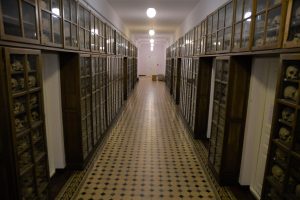The anthropological collection consists of several separate parts: cremations, the skeletal (main) collection, the historical collection of skulls, and a collection of pathological cases.
The skeletal collection consists of 9498 skulls and 6080 postcranial skeletons – the majority of these bones comes from the 16th-18th century and is mostly represented by materials found in Vilnius (59 burial grounds) and other regional towns or villages (156 burial ground). Material from additional 125 burial grounds could be dated to the Iron Age. Overall, the chronology is marked by the first inhabitants of modern Lithuanian territory (Mesolithic-Neolithic) and the Industrial Revolution (late 19th century). A special part of the collection consists of 19th century disarticulated remains belonging to soldiers of Napoleon’s Great Army and well-preserved remains of soldiers from the Imperial Russian Army.

Cremains (cremated remains) come from 145 archaeological sites. The majority of these cremains are dated from the 5th to the 12th century. While analytical techniques to explore the nature of cremated bone have been developed over many years, this project only focused on recording the exact number of available graves (individuals?). The sex assessment and age determination were a major problem due to the fragmented nature of burnt bones – only the measurements and weight of cremains were taken.

Skull collection, consisting of 1558 skulls from the 19th-20th century. It is an integrated part of the Vilnius University osteological collection. Gathered around the end of the 19th and the first half of the 20th century, the skulls are left without a clear context, though cases of syphilis, traumatic injury, or trepanation may serve as unique material for future studies.

Paleopathological cases serve as a unique teaching material. Obtained from commingled graves, these bones are subdivided into several major categories, such as specific and non-specific infectious diseases, trauma, metabolic disorders, etc.

